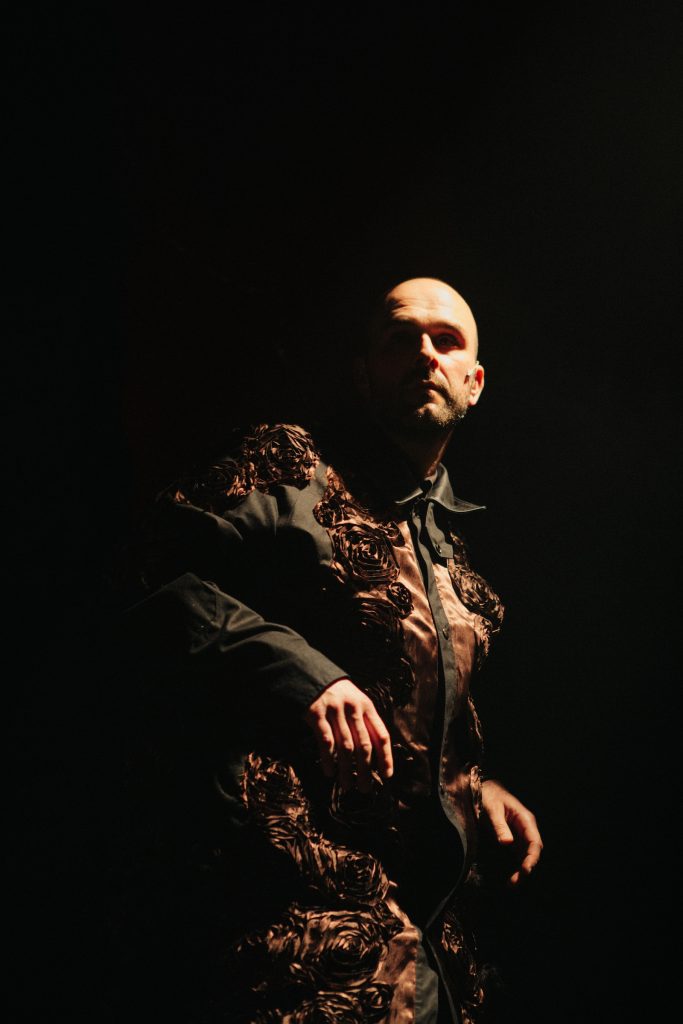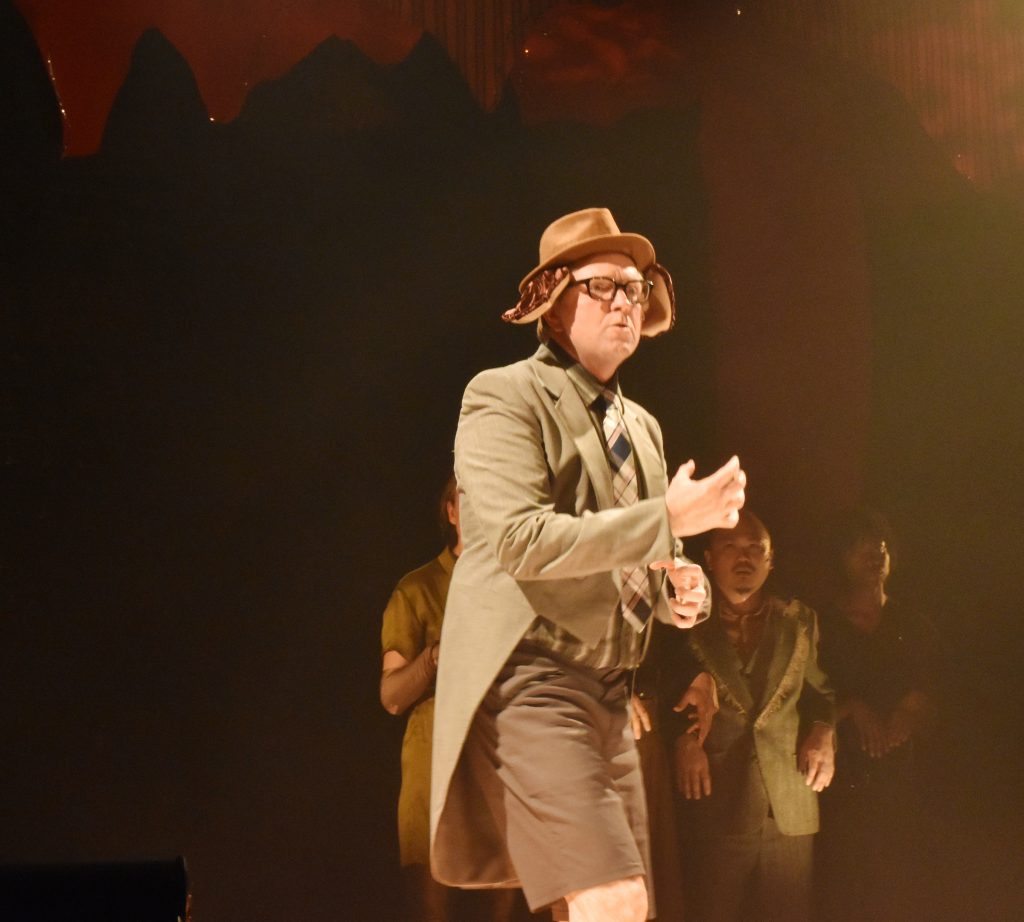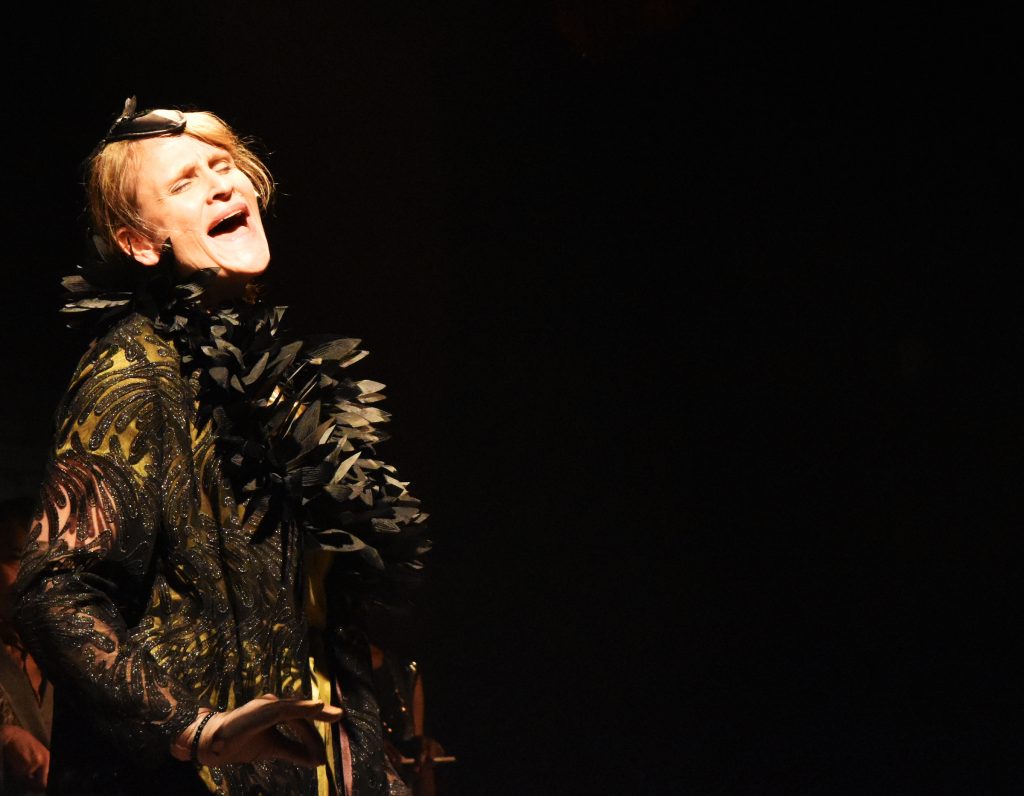
Credit: J Mar Electric
Recorded at the 2019 Luminato Festival in Toronto and presented online by the Cultch
No more performances
Posted January 24, 2021
The only thing that could possibly make The Cave any better would be to see it live. That’s what Toronto audiences were treated to in June 2019 at the Luminato Festival; however, Covid-19 and finances permitting, the show might hit the road in 2022. See it whenever/wherever it goes. Even the online version is stunningly, hauntingly gorgeous.
What the Cultch treated viewers to on January 22, 23 and 24 was the live-streamed video of the Luminato production, performed in an intimate space with a small thrust stage flanked by the band on one side and the audience at cabaret tables on the other. Oh, to have been there!
With lyrics by Cree writer Tomson Highway, music by John Millard and book by Martha Ross, The Cave is apocalyptic cabaret, reminiscent of the collaborations of Bertolt Brecht and Kurt Weill with a whiff of Tom Waits. It’s an end-of-the-world story told from the perspective of various wild animals fleeing a raging forest fire and who find brief refuge in the cave of Bear who welcomes them in. While they await their fate, they sing their stories.

Credit: Delal Hagos
This is not Disney: the animals are not decked out in furry suits, slinky body stockings or feathered coats. There are no whiskered masks, scaly tails or pointy beaks. Under the creative eye of director Adam Paolozza, costume designer Allie Marshall provides just the suggestion of animal; it’s up to the audience to imagine Bear in his full glory or Snake, slithery and skinny. Both director Paolozza and performer Derek Kwan trained at the Ecole Internationale de Théâtre Jacques Lecoq (Paris), the gold-standard in training performers in mime and physical theatre. The movement of the various animals is under-stated but convincing: a cocked head here, a lumbering walk there, a furtive scurrying. Small not big; slight not exaggerated.
The effect, however, is huge.

Credit: Jeremy Marasigan
Throughout the show we hear the crackling and distant roar of fire coming ever closer. We know mankind is to blame (due to human-caused climate change) but John Millard, who plays banjo and doubles as the Narrator, dons a hat with long hound-ish ears, leaves the orchestra pit, takes the stage and sings the only full-on rant against humanity: “These damn humans/they drink wine and chitchat” while the world burns. Let’s “boil them” or “burn them”, Dog rages. In the post-show talk, Millard points out that the animal closest to humans is dog and, not suprisingly, most likely to know how selfish and thoughtless humans can be. It’s a monumental rage but also a hilarious dressing down with Dog shaking like man’s ‘best friend’ emerging from a swim.

Credit: Delal Hagos
Each of the animals sings from its unique perspective: Snake (Andrea Koziol) sings plaintively about her 77 youngsters, all of whose names begin with ‘s’. Beaver (Derek Kwan) complains that the dam he built (“I workworkwork”) will be destroyed by fire. Spider (Neema Bickersteth) sings the Biblical story of mankind’s expulsion from Eden (“I was there”) that parallels the animals’ imminent loss of their homes through no fault of their own. Bear (Alex Samaras) sings, “I was born here/I live here/I laugh here/I play here” but the smoke and crackling fire tell us it will soon be over. These are just four of the animals enacted and sometimes the animals/performers sing haunting harmonies together.
The music, composed by Millard and directed by Gregory Oh, is reminiscent of Weimar-era cabaret, frequently atonal and always excitingly and rhythmically layered. The half-dozen musicians perform on banjo, accordion, organ, piano, clarinet, saxophone, guitar and bass. It’s sort of a Klezmer/Big Top/cabaret hybrid that works magic.

Credit: Delal Hagos
And that is the keyword here: magic. The Cave grows on you as you suspend your disbelief. Moving me close to tears was Crow (Samaras in a ragged black shawl) flying above the burning forest but unable to find his lover Fox in all the smoke. (Narrator Millard had, at the outset, told us to hold on to our socks, “because you will need them to wipe your eyes.”)
The Cave is never preachy, always entertaining. As Highway said in the post-show talk, he does not expect to change the world with The Cave. “We need a whole wave of thinkers”, he says, and if this show starts a little wave in just one viewer, he will have succeeded.
I almost didn’t see this show because I thought it would be too depressing. While there’s not a lot of optimism in it, The Cave is aesthetically spectacular and it’s wonderful that singing animals, usually relegated to Theatre for Young Audiences, have moved to the adult stage where grownups might begin to listen.

